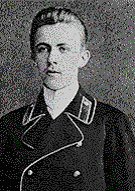Stefan Ossowiecki

Stefan Ossowiecki (1877-1944) was a Polish engineer who was during his lifetime promoted as one of Europe's best-known psychics.[1] Two notable persons who credited his claims were pioneering French parapsychologist Gustave Geley and Nobel Prize-winning physiologist Charles Richet, who called Ossowiecki "the most positive of psychics."
Life
Ossowiecki was born in Moscow in 1877 into an affluent family of former Polish aristocrats. His Moscow-born father, owner of a large chemicals factory and assistant to Dmitri Mendeleev, clung to his Polish heritage and taught his son to speak Polish and to think of himself as a Pole. Stefan Ossowiecki was said to have manifested psychic talents in his youth, much to his family's confusion. When young Stefan told his mother he could see bands of color around people, she took him to an eye doctor, who prescribed drops to cure the condition. The medicine "irritated my eyes but did not diminish my ability," Ossowiecki later recounted.
As a young man, Ossowiecki was enrolled at the prestigious Saint Petersburg Polytechnical University, where he was trained in his father's profession of chemical engineering. It was during this period that Ossowiecki allegedly demonstrated an ability to perform psychokinesis.
After earning his degree, Ossowiecki returned to Moscow, where he lived the life of a sybarite and joined the circle of Czar Nicholas II and the Russian court.
In 1915, his father died and Ossowiecki inherited the family chemicals business, making him temporarily a wealthy man. Only three years later, he lost it all as the Bolshevik Revolution swept the country. As a wealthy capitalist and friend of the czar, Ossowiecki was targeted by the new regime. His property was seized, and he was imprisoned. The isolation of a prison cell forced Ossowiecki to "think through many things ... It was then that I began to fully value this gift given me by the Creator, and I understood that by utilization of it I could help others." He was sentenced to be executed but after half a year he was released, due to support of a friend from his youth, now a Bolshevik party official.
He was released in 1919 and fled Russia, penniless at age 42. Ossowiecki entered business as a chemical engineer in Warsaw. He arranged for his consulting work to complement his work helping people in need.
In the 1920s, many experiments were performed in which Ossowiecki allegedly demonstrated clairvoyance (the ability to see objects in sealed containers) and astral projection (the ability to travel outside the body). Nobel laureate Charles Richet would write in his book Our Sixth Sense, "If any doubt concerning the sixth sense remains ... this doubt will be dissipated by the sum total of the experiments made by Geley, by myself, and by others, with Stefan Ossowiecki."
In 1939, Ossowiecki married a second time[2] and completed a screenplay for Paramount Pictures about his life, The Eyes Which See Everything. In May 1939 he predicted that there would be no war that year and that Poland would retain good relations with Italy[3]—predictions that did not pan out: on September 1, 1939, the Germans invaded Poland and World War II began. However, other sources maintain Ossowiecki had promised Edward Rydz-Śmigły, Commander-in-Chief of Poland's armed forces, not to mention publicly his actual prediction of war[citation needed].
Ossowiecki partly predicted his own death. He told friends that when he died, his body would not be found.[4] He was probably killed by the Gestapo during the Warsaw Uprising, on August 5, 1944, at the building of the former Polish Chief Inspectorate of the Armed Forces on Aleje Ujazdowskie (Ujazdów Avenue). His body was never found; his cenotaph is at Powązki Cemetery.
Notes
- ^ System Miłości Narodów at www.sm.fki.pl
- ^ He never had children. He had two sisters (Wiktoria, Wanda) and three brothers (Stanisław, Henryk, Eugeniusz).
- ^ Wielkopolska Biblioteka Cyfrowa - Dziennik Poranny, May 11 1939, R. 5, Nr 108 at www.wbc.poznan.pl
- ^ Krzysztof Boruń and Katarzyna Boruń-Jagodzińska, Ossowiecki—zagadki jasnowidzenia (Ossowiecki—Mysteries of Clairvoyance), Epoka, 1990.
References
- Stephan A. Schwartz, The Secret Vaults of Time, Grosset & Dunlap, 1978.
- Mary Rose Barrington, Ian Stevenson and Zofia Weaver, A World in a Grain of Sand: The Clairvoyance of Stefan Ossowiecki, Jefferson, NC, and London, McFarland, 2005, 189 pp., $39.95, ISBN 0-7864-2112-6.
- Jerzy Kubiatowski, "Ossowiecki, Stefan (1877-1944)," in Polski Słownik Biograficzny, vol. 24, pp. 431-33.
